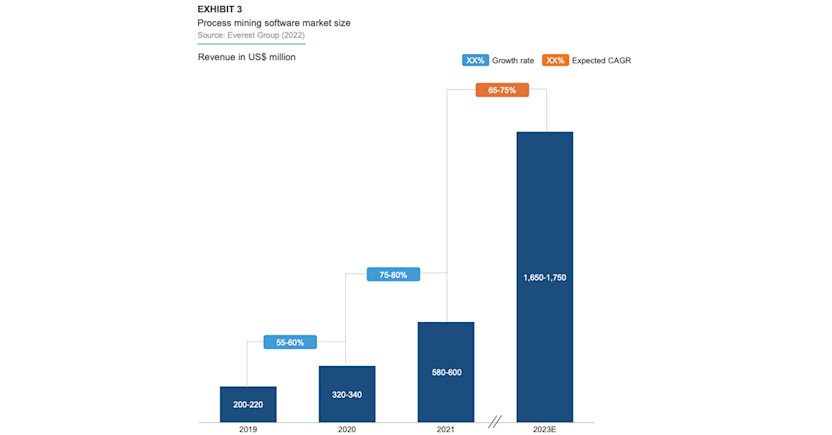
Object-centric process mining addresses challenges outlined by Everest Group report
Process mining will be the foundation for future business transformation and enable the rise of the “fully self-governing enterprise,” say the authors of a recent report from Everest Group. To get there, the global research firm believes process mining providers will need to overcome the limitations of traditional process mining techniques. They’re right. And, object-centric process mining can address these limitations by generating more accurate process models and delivering greater process insights.
A new generation of enterprise software
The process mining software market has experienced rapid growth in the past several years.
According to Everest, the market grew by 55-60% between 2019 and 2020 and by 75-80% from 2020 to 2021. In their report, ”The Evolution of Process Mining: Game-changing Innovations and Future Outlook,” Everest predicts that the process mining software market will reach a value of between $1.65-1.75 billion (US) by the end of 2023.

Everest’s predictions track with Gartner’s assessment that the process mining market would grow 40-50% and pass $1 billion in 2022. Pushing the timeline out to the end of the decade, Polaris Market Research expects the process mining market to be worth $11 billion by 2030.
This dramatic growth is being driven by process mining’s ability to reduce costs and deliver positive operational and strategic results, say the Everest report’s authors. Process mining has moved beyond being a tool for process discovery and conformance monitoring to being a critical component, and often the starting point, for digital transformation and a platform for continuous operational improvement.
For process mining to continue its strong growth however, the authors say the technology needs to overcome several challenges, including:
Lack of solution awareness
Limited availability of quality data
Challenges in data transformation
Increasing complexity across interconnected processes
Security and compliance risks
Internal resistance
Object-centric process mining addresses two of these challenges, data transformation and the complexity of interconnected processes.
Download Everest Group: The Evolution of Process Mining2D process X-Rays vs 3D process MRIs
Object-centric process mining (OCPM) is a new approach to process mining (PM) that produces better process models and provides a deeper understanding of modern business operations.
Classic process mining methods let you analyze and optimize a single process in isolation, such as accounts payable, accounts receivable or procurement. However, today’s business processes are highly interconnected, with a single event (e.g., an online purchase) often involving multiple objects (e.g., the item purchased, the sales order, the invoice, the shipment, etc.) and multiple processes (e.g., order management, procurement, supply chain and production). Traditional process mining software can’t capture the complex relationship between these objects and interconnected processes, but OCPM can.
Like traditional process mining products, OCPM software gathers process data from the information systems that power business operations (e.g., ERP, CRM and SCM). Unlike traditional process mining products, OCPM software stores and analyzes the data in a different way.
Modern business systems often store data in relational databases that capture the one-to-many and many-to-many relationships between process objects. After extracting data from these source systems, traditional process mining software must transform this multidimensional, object-based process data into a flat event log, where each process event (e.g., the creation of a sales order) is tied to a single case (your online purchase vs. your neighbor’s). Additionally, an event log must be created for each object type and analyzed independently. For example, an event log where each case is a sales order could help you understand the most common reason for blocked orders. To look at which customers are paying their invoices on time, you’d need to pull data into a new event log where each case is an invoice, not a sales order.
The data limitations of traditional process mining mean that data extraction and transformation must be repeated, interactions between objects aren’t captured and three-dimensional business processes are squeezed into two-dimensional process models. OCPM solutions address these limitations by storing and analyzing data using an object-centric event log (OCEL). An object-centric event log allows an event to be related to multiple objects and therefore captures the interactions between objects. This means you can analyze specific object types and activities without extracting new data.
Going from traditional process mining to object-centric process mining is like going from a two-dimensional process X-ray to a three-dimensional MRI of your business operations.
As the authors of Everest’s report wrote, “process mining is poised for increased adoption,” but “organizations face several challenges in scaling process mining adoption.” Celonis is giving companies the tools to overcome those challenges with innovations like Process Sphere™, a new capability of Celonis EMS, built on object-centric process mining.
Learn more:



